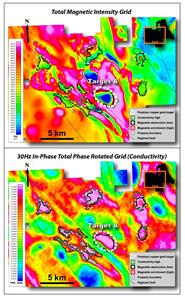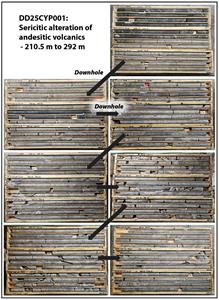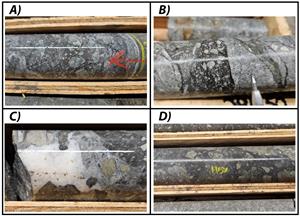
Prosper Gold Refines Target at Cyprus
/EIN News/ -- VANCOUVER, British Columbia, April 22, 2025 (GLOBE NEWSWIRE) -- Prosper Gold Corp. ("Prosper Gold" or the "Company") (TSXV:PGX) provides an update on its winter exploration activities at the Cyprus Project. The Company completed 1,602 metres of drilling and 16 line-kilometres of Induced Polarization (“IP”) surveying at Target A in February and March of 2025. The Cyprus Project is a district-scale porphyry copper-gold project with several historically defined copper ± gold porphyry prospects and significant historical drill results including 138.2 metres at 0.55% copper.
Highlights:
- 3 holes totaling 1,602 metres of diamond drilling were completed at Target A
- All holes intersected quartz-sericite-pyrite (phyllic) alteration, porphyritic intrusions, hydrothermal breccias and intermittent pyrite mineralization
- Subsequent 16-line kilometre IP survey outlines 2.0 x 1.2 kilometre high chargeability anomaly 1.2 kilometres to the southwest of nearest drill hole
- Follow-up drilling planned for summer 2025 targeting high chargeability anomaly
“The maiden drill program at Cyprus was designed to target coincident magnetic and conductivity anomalies outlined from our 2024 property-wide ZTEM survey,” commented Peter Bernier, CEO. “The drill core and the recent IP results indicate that we drilled the margin of a hydrothermal system. We are very excited that the next phase of drilling will utilize all the data we have acquired to more effectively target this covered porphyry system.”
Initial drilling at Target A targeted coincident magnetic low and conductivity high anomalies outlined in the Company’s summer 2024 ZTEM (z-axis tipper electromagnetic) airborne survey (Figure 1). Three drill holes totaling 1,602 metres were designed to test a 2 x 3 kilometre coincident magnetic low / conductivity high.
Following the maiden drill program, a deep-penetrating IP survey was designed to outline the distribution of disseminated sulphides within the hydrothermal system. IP results, along with alteration, lithology and pyrite mineralization observed in drill core, suggest the northeastern margin of the system was drilled. The survey results indicated the vast majority of disseminated sulphides occur 1.2 kilometres to the southwest of the nearest drill hole (DD25CYP002, Figure 2).
The three holes intersected variable amounts of quartz-sericite-pyrite (phyllic) alteration (Figures 3 & 4) spatially associated with porphyritic intrusions (Figure 6). The presence of hydrothermal breccias (Figure 5), fracture-fill and disseminated pyrite mineralization and sericitic alteration suggest the drill holes intersected the periphery of a hydrothermal magmatic system that has the potential to host a porphyry copper deposit. Follow-up drilling is scheduled to commence in early summer 2025.

Figure 1 – Porphyry copper ± gold targets outlined by the summer 2024 ZTEM survey. Total Magnetic Intensity (top) and 30Hz in-phase Total Phase Rotated (bottom) showing relative conductivity at 300 - 500 metres depth.
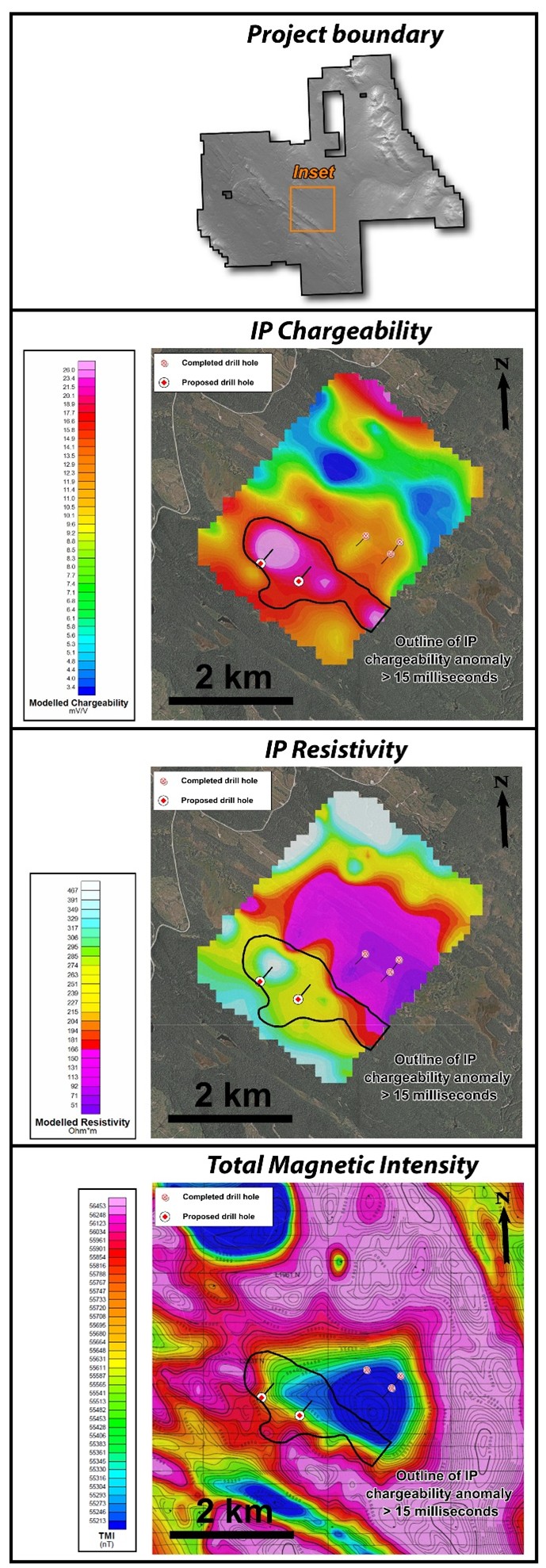
Figure 2 – Maps showing three drill holes completed in February/March of 2025 and two proposed holes targeting chargeability highs outlined in an IP survey completed subsequent to initial drilling. IP depth slices at -300 m.
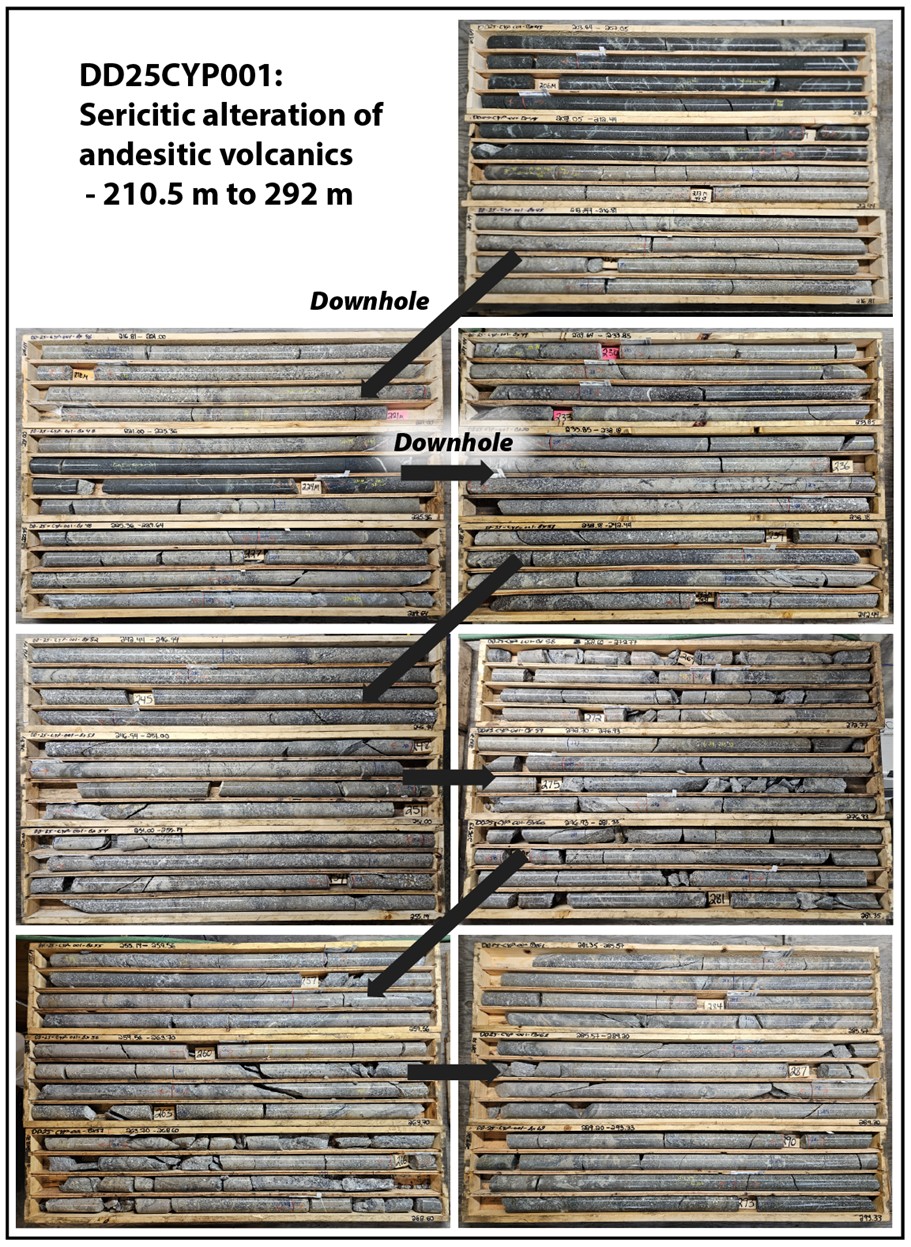
Figure 3 - Late sericite alteration within andesitic volcanics - Drill hole DD25CYP001.

Figure 4 - Examples of quartz-sericite-pyrite alteration and mineralization. A) Quartz-sericite-pyrite altered andesitic volcanics. Pyrite as disseminations and blebs (DD25CYP001 – 213.3 m). B) Abundant fine disseminated pyrite within strongly quartz-sericite altered andesites (DD25CYP001 – 229.9 m). C) Abundant disseminated to semi-massive pyrite within strongly quartz-sericite altered andesites (DD25CYP001 – 373.3 m). D) Abundant fine disseminated pyrite replacing groundmass and at silica replacement sites (DD25CYP001 – 229.5 m). E) Blebby pyrite within silica-sericite altered andesite (DD25CYP003 - 243.2 m). F) Pyrite stringers in silica-sericite altered feldspar porphyry andesite (DD25CYP002 – 362 m).

Figure 5 - Examples of hydrothermal breccia encountered in February/March 2025 drilling. A) Hydrothermal breccia with milled clasts of quartz and pyrite (DD25CYP003 – 331.5 m). B) Hydrothermal breccia with silica and pyrite cement (DD25CYP002 – 284.3 m). C) Multi-phase hydrothermal breccia with dark grey silica-pyrite groundmass with carbonate cement and pyrite clasts (DD25CYP001 – 351.7 m). D) Hydrothermal breccia with silica-pyrite matrix (DD25CYP001 – 377.1 m)
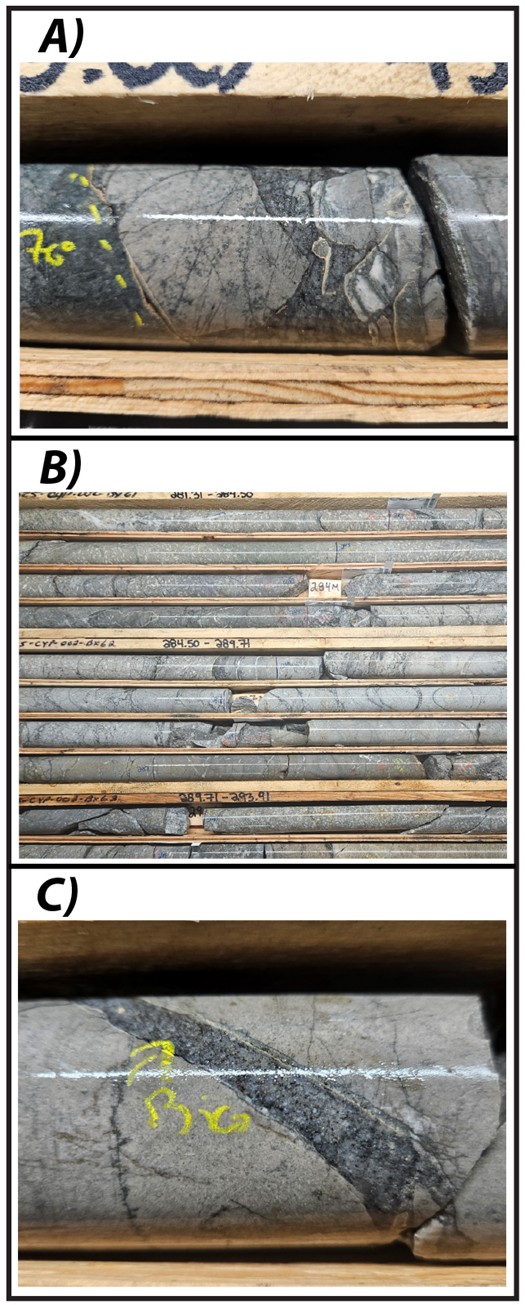
Figure 6 - Examples of intrusions from February/March 2025 drilling. A) Intrusive breccia with strongly silica-sericite-pyrite altered clasts intruded by biotite-feldspar porphyry (DD25CYP003 – 453.3 m). B) Monzonitic intrusive rocks with sooty pyrite veining (DD25CYP002 – 281 to 292 m). C) Biotite-felspar porphyry dikelet with strongly silica-sericite-pyrite altered wallrock (DD25CYP003 – 453.5 m).
Table 1 - Drill hole information from February/March 2025 maiden drilling program (coordinates provided in UTM NAD 83, zone 9).
| Hole ID | Easting (m) | Northing (m) | Azimuth (°) | Dip (°) | Length (m) |
| DD25CYP001 | 664,461 | 6,197,242 | 215 | -60 | 500 |
| DD25CYP002 | 664,061 | 6,197,533 | 215 | -60 | 500 |
| DD25CYP003 | 664,607 | 6,197,438 | 215 | -70 | 602 |
About the Cyprus Project
The road-accessible Cyprus Project is situated in north-central British Columbia, Canada. The 623 square kilometre Project includes the historical Kaza and Northstar copper prospects (see the Company’s February 20th, 2024 and February 26th, 2024 news releases for details) and represents a district-scale copper-gold porphyry exploration Project.
At the historical Kaza copper-gold prospect, soil samples up to 5.09 gpt gold and 10,000 ppm copper and surface rock chip samples from 1973 including 0.88% copper, 15.4 gpt gold and 120 gpt silver over 4.0 metres coincide with a 2,000 by 600 metre area of high IP chargeability and low magnetic response. The presence of sparse feldspar porphyry dikes and the sulphide assemblages present at surface suggest copper-gold porphyry mineralization may improve at depth.
Copper mineralization at the Northstar prospect consists of vein-hosted and disseminated chalcocite and bornite within faulted and fractured andesite. Surface trench sampling results includes 23.0 metres grading 2.1% copper and historical drilling intercepts include 0.55% copper over 138.2 metres. Zones of copper mineralization outlined by previous operators at the Northstar prospect are likely driven by a magmatic-hydrothermal system in the immediate vicinity.
The Big-Time prospect has not seen historical drilling despite the presence of a pronounced copper-bearing area of phyllic alteration that coincides with strong copper-molybdenum geochemistry, high IP chargeability and northeast trending feldspar porphyry dikes.
A heli-borne ZTEM (z-axis tipper electromagnetic) geophysical survey comprising 3,760 line-kilometres was completed over the entirety of the Cyprus Project in the summer of 2024. Numerous porphyry copper ± gold exploration targets were outlined, including Target A, which is characterized as a 2 x 4 kilometre conductivity high anomaly coincident with a 2 x 3 kilometre magnetic low anomaly proximal to a regionally mapped NW-trending fault. Initial drilling at Target A indicates the presence of a magmatic-hydrothermal system related to porphyritic intrusions.
Qualified Person
The scientific and technical information in this news release has been reviewed by Rory Ritchie, P.Geo., Vice-President of Exploration for Prosper Gold and a Qualified Person under National Instrument 43-101.
For an overview of Prosper Gold please visit www.ProsperGoldCorp.com
ON BEHALF OF THE BOARD OF DIRECTORS
Per: “Peter Bernier”
Peter Bernier
President & CEO
For further information, please contact:
Peter Bernier
President & CEO
Prosper Gold Corp.
Cell: (250) 316-6644
Email: Pete@ProsperGoldCorp.com
Information set forth in this news release may involve forward-looking statements under applicable securities laws. Forward-looking statements are statements that relate to future, not past, events. In this context, forward-looking statements often address expected future business and financial performance, and often contain words such as "anticipate", "believe", "plan", "estimate", "expect", and "intend", statements that an action or event "may", "might", "could", "should", or "will" be taken or occur, or other similar expressions. All statements, other than statements of historical fact, included herein including, without limitation, statements about the planned exploration of the Cyprus Project, are forward-looking statements. By their nature, forward-looking statements involve known and unknown risks, uncertainties and other factors which may cause our actual results, performance or achievements, or other future events, to be materially different from any future results, performance or achievements expressed or implied by such forward-looking statements. Such factors include, among others, the following risks: the need for additional financing; operational risks associated with mineral exploration; fluctuations in commodity prices; title matters; environmental liability claims and insurance; reliance on key personnel; the potential for conflicts of interest among certain officers, directors or promoters with certain other projects; the absence of dividends; competition; dilution; the volatility of our common share price and volume and the additional risks identified the management discussion and analysis section of our interim and most recent annual financial statement or other reports and filings with the TSX Venture Exchange and applicable Canadian securities regulations. Forward-looking statements are made based on management's beliefs, estimates and opinions on the date that statements are made and the Company undertakes no obligation to update forward-looking statements if these beliefs, estimates and opinions or other circumstances should change, except as required by applicable securities laws. Investors are cautioned against attributing undue certainty to forward-looking statements.
Neither the TSX Venture Exchange nor its Regulation Services Provider (as that term is defined in the policies of the TSX Venture Exchange) accepts responsibility for the adequacy or accuracy of this release.
Photos accompanying this announcement are available at
https://www.globenewswire.com/NewsRoom/AttachmentNg/0e5ec85b-5fa9-4d3a-975b-b293e07f3df9
https://www.globenewswire.com/NewsRoom/AttachmentNg/f2912730-7a32-43b6-ba6a-725fbc1169d0
https://www.globenewswire.com/NewsRoom/AttachmentNg/bdb7844b-bcba-44f7-bcac-1394a59f9bc1
https://www.globenewswire.com/NewsRoom/AttachmentNg/01025f27-acec-4976-92ed-43c37c419269
https://www.globenewswire.com/NewsRoom/AttachmentNg/1f6d3f64-7c69-4791-af9e-c77a3a4df819
https://www.globenewswire.com/NewsRoom/AttachmentNg/58ca0b5e-07ac-4916-832c-0b471b443477

Figure 1
Porphyry copper ± gold targets outlined by the summer 2024 ZTEM survey. Total Magnetic Intensity (top) and 30Hz in-phase Total Phase Rotated (bottom) showing relative conductivity at 300 - 500 metres depth.
Figure 2
Maps showing three drill holes completed in February/March of 2025 and two proposed holes targeting chargeability highs outlined in an IP survey completed subsequent to initial drilling. IP depth slices at -300 m.
Figure 3
Late sericite alteration within andesitic volcanics - Drill hole DD25CYP001.
Figure 4
Examples of quartz-sericite-pyrite alteration and mineralization. A) Quartz-sericite-pyrite altered andesitic volcanics. Pyrite as disseminations and blebs (DD25CYP001 – 213.3 m). B) Abundant fine disseminated pyrite within strongly quartz-sericite altered andesites (DD25CYP001 – 229.9 m). C) Abundant disseminated to semi-massive pyrite within strongly quartz-sericite altered andesites (DD25CYP001 – 373.3 m). D) Abundant fine disseminated pyrite replacing groundmass and at silica replacement sites (DD25CYP001 – 229.5 m). E) Blebby pyrite within silica-sericite altered andesite (DD25CYP003 - 243.2 m). F) Pyrite stringers in silica-sericite altered feldspar porphyry andesite (DD25CYP002 – 362 m).
Figure 5
Examples of hydrothermal breccia encountered in February/March 2025 drilling. A) Hydrothermal breccia with milled clasts of quartz and pyrite (DD25CYP003 – 331.5 m). B) Hydrothermal breccia with silica and pyrite cement (DD25CYP002 – 284.3 m). C) Multi-phase hydrothermal breccia with dark grey silica-pyrite groundmass with carbonate cement and pyrite clasts (DD25CYP001 – 351.7 m). D) Hydrothermal breccia with silica-pyrite matrix (DD25CYP001 – 377.1 m)
Figure 6
Examples of intrusions from February/March 2025 drilling. A) Intrusive breccia with strongly silica-sericite-pyrite altered clasts intruded by biotite-feldspar porphyry (DD25CYP003 – 453.3 m). B) Monzonitic intrusive rocks with sooty pyrite veining (DD25CYP002 – 281 to 292 m). C) Biotite-felspar porphyry dikelet with strongly silica-sericite-pyrite altered wallrock (DD25CYP003 – 453.5 m).
Distribution channels: Media, Advertising & PR, Mining Industry ...
Legal Disclaimer:
EIN Presswire provides this news content "as is" without warranty of any kind. We do not accept any responsibility or liability for the accuracy, content, images, videos, licenses, completeness, legality, or reliability of the information contained in this article. If you have any complaints or copyright issues related to this article, kindly contact the author above.
Submit your press release

